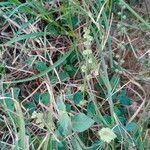Perennial herb, erect or clambering, often much branched, ½-2 m high; stem obtusely quadrangular or subterete, thickened above the nodes, finely pubescent. Leaves ovate-oblong from a rounded, obtuse or acute base, contracted into the petiole, acutely acuminate, on both surfaces glabrous or more or less densely clothed with shorter or longer, appressed or obliquely patent, white hairs, 2-12 by 1¼-7 cm; petiole 2-25 mm, finely pubescent. Spikes (racemes) terminal and in the highest leaf axils, erect of obliquely erect, 6-35 cm long (1-10 cm peduncle included), finely and more or less densely patently pilose. Flower-clusters sessile or very shortly stalked, lower remote, higher ones crowded, all clusters at first erect, afterwards patent, consisting of 2-3 ☿ flowers and several rudimentary ones; highest ☿ flowers solitary without accompanying rudimentary flowers; bracts and bracteoles ovate-oblong, acute, pilose; bracts 2½-5 mm long, soon widely patent or reflexed; bracteoles 2½-4 mm. Tepals oblong or ovate-oblong, with a short acicular apical point, 4-5 mm long, dull pale green, albido-pilose outside, inside glabrous. Staminal cup ⅓-½ mm high, slightly fleshy; free parts of the filaments ± 2 mm, often pink; anthers ± ½ mm. Ovary with a narrow base and a clearly delimitated broadly rounded apex; style 1½-1¾ mm. Utricle 2-2½ mm long; seed shining dark brown; rudimentary flowers at first subsessile and small, afterwards borne on a distinct, villous pedicel and much accrescent; hooks finally 3-4 mm long, pale green or purple, glabrous above the villous base.
Inflorescences at first more or less dense, elongating to as much as 0.5 m. in fruit with the lower flowers becoming increasingly remote, axis subglabrous to tomentose, peduncle c. 1–10 cm. long; bracts lanceolate, 1.5–2.5 mm. long, persistent, more or less deflexed after the fall of the fruit, subglabrous or pilose, sharply mucronate with the percurrent midrib; partial inflorescences mostly of one solitary hermaphrodite flower subtended on each side by a triad of one hermaphrodite and 2 modified flowers; bracteoles of each triad broadly subcordate-ovate, (2.75)3–5(6) mm., abruptly narrowed to the stramineous to dark arista forming by the excurrent midrib, membranous with a pale margin, thinly to very densely hairy; bracteoles of sterile flowers ovate-lanceolate, usually more shortly and less densely pilose.
Leaves variable to shape and size, from narrowly ovate-elliptic to oblong or circular, 2 10 (14) × 1–5(7) cm., acuminate to obtuse-apiculate or retuse at the summit, shortly or more longly cuneate at the base, narrowed to a petiole 0.5–2.5(3.5) cm. long; indumentum of lamina varying from sericeous or tomentose to subglabrous with a few hairs running vertically along the lower surface of the primary venation, rarely quite glabrous, commonly moderately pilose with the hairs along the nerves divergent.
An annual herb. It can lie along the ground or be erect. It has several stems and can be a climber or scrambler. It can keep growing for a few years. It can grow 90 cm high or scramble to 2.5 m long. It is usually hairy. The leaves are oval or rounded. They are opposite. The flowers are in clusters at the ends of the plant. They have stiff, hooked bristles. The fruit are burrs with barbs. They are 8-18 mm across. The seeds are dark brown and shiny. They are 2 mm long. There are 4 varieties.
Tepals oblong-ovate to lanceolate-ovate, more or less quickly narrowed to a rather obtuse mucronate apex to gradually narrowed and acute-aristate, the outer two (3.5)4–5(6) mm. long, subglabrous to more or less tomentose dorsally, 3(5)-nerved, the midrib and 2 inner nerves confluent just below the apex and excurrent in the mucro or short arista, inner 3 slightly shorter and more densely pilose.
Annual or perennial herb, more or less erect and c. 0.3–0.9 m. tall, or prostrate and sprawling, or subscandent and scrambling to as much as 2.5 m., stem generally much-branched and swollen at the nodes, branches opposite, divaricate or ascending, slender; stems and branches obtusely 4-angled to almost terete, thinly pilose to densely tomentose.
Branches of sterile flowers 3, each terminating in (3)5–18 (20) mm. long setae in 1–3 ranks; setae subglabrous to more or less villous in the lower half, yellowish to purple or red, (1.5)3–7 mm., the partial inflorescence falling intact to form a burr c. 8–18 cm. in diam.
Annual herb, 0.3-0.9 m high, erect. Leaves opposite, broad, entire, petiolate. Inflorescence a spiciform, bracteate thyrse, terminal on stems and branches. Flowering time Feb.? Seed oblong-ovoid or ovoid, black, slightly compressed.
Shortly hairy, sprawling perennial to 50 cm. Leaves ovate, petiolate, often attenuate, pale beneath. Flowers in congested, elongate spikes elongating in fruit, whitish, fruits spiny and falling in burr-like clusters when ripe.
Seed oblong-ovoid with a prominent radicle, 2 mm. long, dark brown, shining, testa at first faintly reticulate but finally smooth or punctulate.
Style short to rather slender, (0.5)0.9–2(3) mm. long.
A weed, 2–4 ft. high, sometimes woody below
Capsule ovoid, 2–2.5 mm. long.
Yellow or red stamens
Greenish flowers
Burr fruits.


